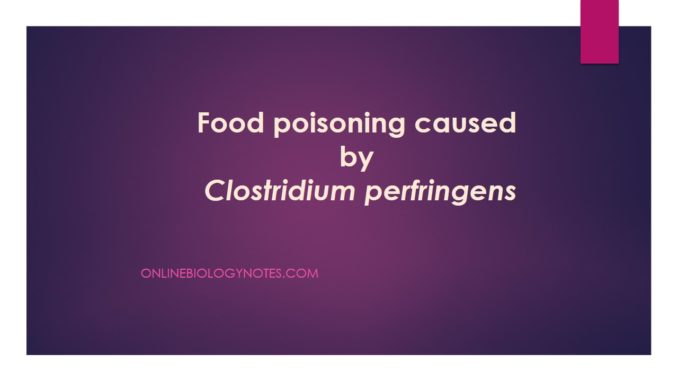
Clostridium perfringens gastroenteritis
- Clostridium perfringens causes food borne gastroenteritis which is due to enterotoxin production.
- Clostridium perfringeus multiply and produce enterotoxin in food.
- After ingestion, it further multiplies in intestinal tract and produce further enterotoxin.
- Therefore, gastroenteritis caused by Clostridium perfringens is food infection rather than intoxication.
Etiological agent:
- Clostridium perfringens is gram +ve, non-motile, anaerobic, spore forming rod shaped bacteria.
- However, Clostridium perfringens occasionally survive in presence of O2 , minimum, optimum and maximum temperature for growth are 15oC, 43-47oC and 55oC respectively.
- pH range is 5-9. It is inhibited by 5% NaCl (minimum Aw 0.97).
- They produce 5 types of antigenically different enterotoxins A, B, C, D, and E.
- Clostridium perfringens are also classified into 5 groups on the basis of type of enterotoxin they produce.
- Main food poisoning strain is type A. However, food poisoning by type C strain are also reported in some countries.
- Enterotoxin of Clostridium perfringens is a structural component of spore. Therefore, toxin is produced during spore formation.
- Clostridium perfringens is found in soil, water, dust and intestinal tract of human beings.
- Therefore, it is excreted in stool of healthy individual, from where it contaminates the foods.
Food involved:
- Meat and meat products are mainly associated with food poisoning by Clostridium perfringens.
- It is because it is a normal flora of intestinal tract from where it directly enters into meat.
- In case of other food, it occurs by contamination of bacterial spore from stool, soil, dust, etc.
- Insufficient heating or warming of food stimulates spores for germination.
- Therefore, food which are insufficiently heated and then stored unfrozen are highly susceptible to spoilage.
Pathogenesis of Clostridium perfringens gastroenteritis:
- When contaminated food is ingested, pre-formed enterotoxin as well as viable bacterial cell enter into intestinal tract.
- In intestine Clostridium perfringens multiply and produce further enterotoxin during sporulation.
- Then enterotoxin bind to the cell of intestinal epithelium and enters into intestinal epithelial cell.
- This enterotoxin causes secretion of water and electrolyte from intestinal cell into intestinal lumen and causes diarrhea.
- This enterotoxin is also cytotoxic and kills intestinal epithelial cells.
Disease symptoms of Clostridium perfringens gastroenteritis:
- Incubation period is 8-24hrs.
- Abdominal pain and diarrhea are two typical symptoms.
- In contrast to staphylococcal food poisoning, vomiting is rare.
- The disease is of short duration and usually remains for a day or less.
- Mortality rate is very low and requires high dose of bacteria to be fatal.
Treatment of Clostridium perfringens gastroenteritis:
- Treatment involves giving self-solution to counteract loss of water and electrolyte during diarrhea.
Prevention and control of Clostridium perfringens gastroenteritis:
- Food poisoning by Clostridium perfringens can be prevented by:
- Preventing contamination:
- For this purpose, sanitary practice is important to prevent contamination of spore of bacteria into food.
- Preventing germination of spore and growth in food:
- Various methods can be used to prevent germination of spore and multiplication of bacteria in food.
- One simple method is to freeze food adequately during storage.
- Killing organism before eating food:
- By heating vegetative cells are easily kill but spores are resistant.
- γ radiation can be used to kill spore in food just before eating.
